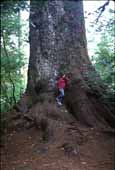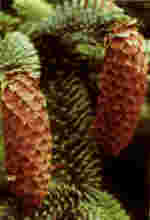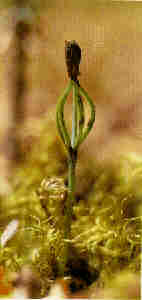
One of the largest known specimens, at Lake Quinault, Washington [C.J. Earle, 5-Sep-1992].

Cones (6).

Seedling (4).
Common Names
Sitka spruce, tideland spruce, coast spruce, Menzies spruce (1, 2), épinette de Sitka (8).Taxonomic notes
Syn: Pinus sitchensis Bongard 1832; Abies falcata Rafinesque; A. menziesii (Douglas ex D. Don) Lindley 1835, not Mirbel 1825; Picea falcata (Rafinesque) Suringar; P. menziesii (Douglas ex D. Don) Carrière; Pinus menziesii Douglas ex D. Don (8).Freely hybridizes with P. glauca to form Lutz or Roche spruce, P. × lutzii , wherever the ranges of the two species overlap, such as along major river corridors across the BC Coast Range and in coastal AK. May also hybridize with Picea engelmannii (6).
Description
Tree to 80 m tall and 500 cm dbh with straight trunk from buttressed base and an open, conical crown of horizontal branches. Bark grey, smooth, thin, becoming dark purplish-brown with scaly plates. Branches somewhat drooping; twigs not or slightly pendent, rather stout, pinkish brown, glabrous, rough, with peglike bases. Buds reddish brown, 5-10 mm, apex rounded. Needles (1.2)1.5-2.5(3) cm, flattened or broadly triangular in cross section (lower surface rounded or slightly angular), rather rigid (painfully sharp), blue-green to light yellow-green, upper surface darker green with stomatal bands very narrow or absent, lower surface glaucous with conspicuous stomatal bands separated by ridge, apex sharp-pointed, dark green, 15-25 mm long. Ovulate cones 5-9 (-10) cm long, cylindrical, short-stalked, green or reddish, ripening pale buff to light orange-brown, pendant from ends of twigs, opening at maturity and falling soon after. Cone scales variable, elliptic to narrowly diamond-shaped, 15-22 × 12-16 mm, rather thin and flexible, margin at apex erose, apex extending 4-8 mm beyond seed-wing impression. 2 n =24 (1, 8). Bract scale the longest of any spruce, to 7-8 mm long and very occasionally slightly exserted by up to 0.5 mm on basal scales.Range
Along the northwest coast of North America from Kodiak Island in the western Gulf of Alaska to Mendocino County, California, never more than 200 km from the sea and usually much closer. See also (12). USDA hardiness zone 7 (Californian origins zone 8; hybrid P. × lutzii zone 5). Grows at timberline (ca. 1000 m) in Alaska, while remaining below 400 m in California. Typically found in areas with high rainfall and a cool climate, although a considerable range of precipitation and temperature values is encountered across this species' wide latitudinal range. Usually found growing on well-drained acidic soils, in pure stands or with Tsuga heterophylla . Other frequent associates, as they might be encountered traveling from the southern to northern limits of Sitka spruce's range, include the conifers Sequoia sempervirens , Chamaecyparis lawsoniana , Pseudotsuga menziesii , Pinus monticola , Chamaecyparis nootkatensis , Pinus contorta var. contorta, Tsuga mertensiana , Picea glauca , and Abies lasiocarpa . An important hardwood associate is Alnus rubra , which often colonizes gravel bars along large rivers at the same time as Sitka spruce (7).
Big Tree
The world's largest spruce (2). In old growth stands, trees may commonly reach a height of 70 m and diameter of 300 cm. A specimen at Lake Quinault in Olympic National Forest, WA, has a height of 58.2 m, dbh of 572 cm, and crown spread of 29 m. Another, near Seaside, OR, has a 544 cm dbh, a height of 63 m, and a crown spread of 28 m (9). The tallest tree on record, 96.0 m with a dbh of 305 cm, is in Pacific Rim National Park in BC (10).Oldest
Thought to be 700 or 800 years (7), but no supporting data are available.Dendrochronology
Ethnobotany
The sharp needles were believed to give this tree special powers of protection against evil thoughts (though not from chainsaws). Various Northwest Coast peoples have eaten the inner bark or the young shoots; the latter are an excellent source of vitamin C (also much appreciated by the native elk, Cervus canadensis ). The pitch was chewed for pleasure and as a medicine for various skin irritations. The roots, peeled, split and dried, were used to make twined, water-tight hats and baskets (6).Western society regards Sitka spruce as one of the foremost timber species in its region and also in NW Europe, where it is by far the most widely planted timber tree. The lumber has a high strength-to-weight ratio. It is preferred for acoustic uses such as piano sounding boards and guitar tops and also makes superior ladders, masts, spars, oars, and experimental airplane components including frames and propellers (7).
Observations
The most famous, and perhaps the best, places to see old growth Sitka spruce forests are the Hoh and other river valleys of western Olympic National Park (WA), and Pacific Rim National Park and Carmanah Pacific Provincial Park on Vancouver Island (BC). The former site includes the largest spruce, and the latter the tallest. See (11) for details on visiting these areas and finding the largest trees.Remarks
Together, Sitka spruce and western hemlock dominate one of the great forest types of North America, the coastal forest of the Pacific Northwest. Their native environment is characterized by a cool, moist maritime climate (3).The most widespread forest disturbance in this environment is windthrow. Severe storms, occurring at intervals of decades to centuries, may flatten entire forests. Wind is also an important chronic disturbance, contributing to about 80% of within-stand mortality in these forests (3). Both spruce and hemlock have adapted to this situation in a distinctive way: their seedlings typically germinate and thrive on a substrate of decaying conifer wood. An old growth spruce-hemlock forest is thus characterized by the presence of"nurse logs," logs that may be covered with seedlings of hemlock and spruce (4).
One consequence of life in a cool, moist maritime climate is the development of huge aboveground biomass accumulations, mostly in the form of live and decaying wood. Old growth Sitka spruce-western hemlock forests have been found to have an average aboveground biomass of 1163 tonnes per hectare, a value exceeded only by forests of giant sequoia and redwood (3).
Sitka spruce is also somewhat noteworthy for its tolerance to salt spray, which permits this species to occur on rocky sites along the seashore, sometimes with lodgepole pine, another species tolerant of the salt. Spruce growing in such an environment often show a gnarled and twisted growth form reminiscent of trees growing at timberline. This growth form has been shown to be related to the production of increased amounts of coumarin, a growth hormone widespread among conifers (5).
Trees typically begin to produce cones at 15 to 40 years of age. Seeds are small, with an average weight of 2.2 mg. Most seed is dispersed within 6 weeks of initial cone opening, and dispersal is by wind. Trees grow slowly for the first few years after germination but growth then increases rapidly, with heights at 100 years of age ranging from 33 m in Alaska to 48 m in Oregon (7); in cultivation in Britain, growth rates of 40 m in 43 years, and 60 m in 110 years, are recorded on the best sites (A F Mitchell).
This is one of the few conifer species that can produce epicormic branches. If a stand is opened up to light, for instance by an adjacent clearcut, new branches may originate along the exposed tree trunks (7).
Sitka spruce is the state tree of AK (8).
Citations
(1) Peattie 1950(2) Little 1980
(3) Franklin Jerry F. 1988. Pacific Northwest forests. P.103-130 in M.G. Barbour & W.D. Billings (eds.), North American terrestrial vegetation. Cambridge: Cambridge University Press.
(4) Kirk, R. and J.F. Franklin. 1992. The Olympic rain forest: an ecological web. Seattle, WA: Univ. of Wash. Press.
(5) Löve, Doris, Carol Mclellan and Igor Gamow. 1970. Coumarin and coumarin derivates in various growth-types of Engelmann spruce. Svensk Botanisk Tidskrift 64(3): 284-296.
(6) Pojar and Mackinnon 1994 .
(7) A.S. Harris in Burns & Honkala 1990 .
(8) Ronald J. Taylor at the Flora of North America web site .
(9) American Forests 1996 .
(10) Stoltmann, R. 1993. Guide to the record trees of British Columbia. W Can. Wilderness Comm. 58 pp.
(11) Stoltmann, R. 1996. Hiking the ancient forests of British Columbia and Washington. Vancouver, BC: Lone Pine.
(12) Robert S. Thompson, Katherine H. Anderson and Patrick J. Bartlein. 1999. Atlas of Relations Between Climatic Parameters and Distributions of Important Trees and Shrubs in North America. U.S. Geological Survey Professional Paper 1650 A&B. URL= http://greenwood.cr.usgs.gov/pub/ppapers/p1650-a/pages/conifers.html , accessed 22-Jan-2000.
See also:
Farjon 1990
.
Franklin and Dyrness 1988
.
FEIS database
.
Daubenmire, R. 1968. Some geographic variations in
Picea sitchensis
and their ecologic interpretation.
Canadian Journal of Botany
46:787-798.
This page co-edited with Michael P. Frankis, Dec-1998.
[ Picea ] [ Pinaceae ] [ home ]
This page is from the Gymnosperm Database
URL: http://www.geocities.com/~earlecj/pi/pic/sitchensis.htm
Edited by Christopher J. Earle
E-mail:
earlecj@earthlink.com
Last modified on 24-Jan-2000